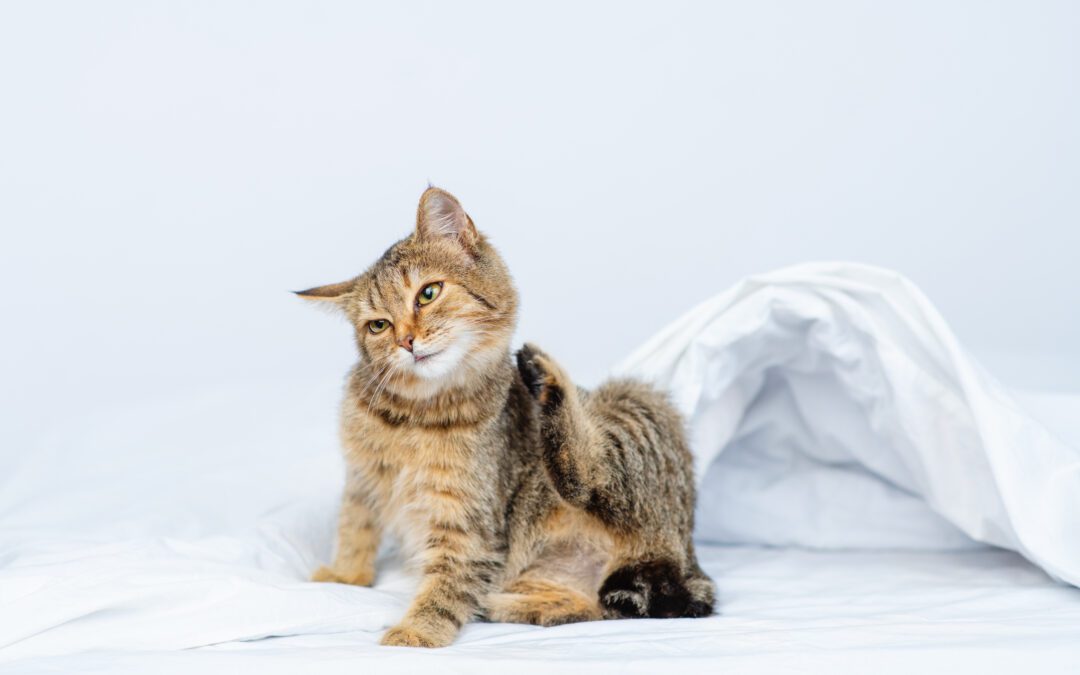Help! My cat has fleas!
Fleas are best found on a cat by looking along the cat’s belly, around the lower back and the tail base, as well as around the head. You may actually see the flea scurrying around or you may only see flea dirt. Flea dirt is flea poop, which is digested blood (fleas feed on their hosts’ blood). It looks like ground pepper. If you wet the specs of dirt, they will leave a reddish rust color on a white towel. Using a flea or lice comb makes it easy to find the flea dirt.
Adult Fleas live on the cat. They lay thousands of eggs (that look like white specs of salt) which fall off the cat into the environment. (An adult female flea can lay more than 5,000 eggs in her lifetime.) Within about 2 weeks, these eggs start hatching into larvae. These eggs can also stay dormant for long periods of time – 6 months to a couple of years. The larvae then enter a pupae stage. The eggs & pupae are resilient and are difficult to kill. Because of the large number of eggs in the environment, it is necessary to treat the cat’s living environment as well as treating the cat. Vacuuming a lot (throwing out the vacuum bags where the early stages of fleas can live), steam cleaning, washing bedding weekly, exterminating with bombs or getting an exterminator may be helpful.
My ABSOLUTE FAVORITE topical product is Revolution Plus. It is an all-around parasiticide for cats:
It sterilizes & kills fleas quickly
It kills mites (ear mites, scabies, cheyletiella)
It prevents heartworm infection (commonly transmitted to cats by mosquitos) It controls intestinal worms (roundworms and hookworms)
It kills the brown dog tick (and may kill other types of ticks as well)
It is a prescription only product and may be purchased from your veterinarian.
Also available are Frontline Plus for Cats & Catego & Vectra for Cats. And now a new oral prevention, Credelio for Cats.
Capstar is an oral pill that kills fleas that are crawling on your cat; within half an hour the fleas are falling off and dying. Its effects last less than a full day and therefore does not have a longer residual effect, so you will need to use a topical or oral product as well.
Treating the Cat and any other pets in the environment is very important. Treatment should continue year-round in flea infected environments. Even in the middle of a very cold winter, we see many cats loaded with fleas because their environment has become infested. Topical or oral flea products are the best approach. Routine, consistent and continuous treatment is extremely important to rid the environment and your pets of fleas.
Make sure that the product you choose is SAFE for CATS. Many products are not safe for cats. READ the LABELS carefully. For example, Permethrins are toxic to cats. Pyrethrins are usually safe, but they aren’t as effective as newer products, because fleas have become resistant over decades to these older products. Most flea collars are pyrethrin based. Flea collars are not effective in ridding the cat of a flea problem. Organic or natural products are available but may be toxic to cats (like citric extracts). Brewer’s yeast, garlic & ultrasonic or light devices have not been proven to work.
It is also important to realize that Fleas TRANSMIT many diseases and parasites to cats and dogs (and to their other hosts: rodents, wildlife, birds), some of which can be transmitted to HUMANS. They can transmit viruses, bacteria, rickettsia, protozoa and helminths. To name a few: Yersinia pestis (Bubonic Plague), Typhus, Bartonella (cat scratch fever), tape worms, Myxomatosis, Trypanosomes.

